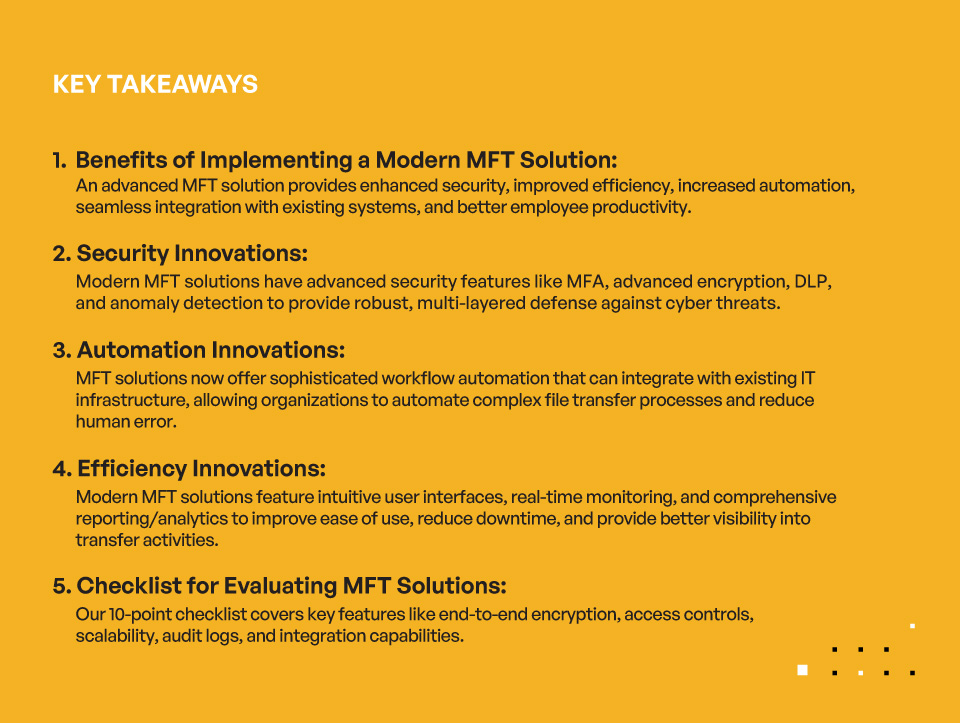
Innovations in Managed File Transfer: Your Checklist for a Modern MFT Solution
Managed file transfer (MFT) is highly valued by organizations for its ability to handle all aspects of inbound and outbound file transfers securely, efficiently, and reliably.
Traditionally, organizations used simple techniques like file transfer protocol (FTP) to move files. However, in today’s evolving business landscape, which includes an ever–increasing amount of sophisticated cyber threats, these legacy file transfer solutions are not suitable because they lack necessary security measures, visibility, and management capabilities. Instead, an increasing number of businesses are implementing modern managed file transfer solutions to meet their complex file transfer, as well as regulatory compliance needs.
Still debating between FTP and managed file transfer? Here are six reasons why managed file transfer is better than FTP .
In this blog post, we’ll take a close look at the recent innovations in managed file transfer that have enabled organizations to transfer files to trusted securely, efficiently, and in compliance with regulations like CMMC, HIPAA, PIPEDA, ITAR, and other regulations. These innovations will also help you identify the right managed file transfer solution for your organization, based on your specific business needs.
Defining Modern Managed File Transfer
The transition from traditional file transfer methods to modern managed file transfer solutions has been driven by advancements in technology and increased cyber threats. Modern managed file transfer solutions have advanced significantly beyond the basic file transfer capabilities, offering more than just a secure method for transferring files. These solutions now provide unprecedented levels of control, automation, and visibility, enabling organizations to handle larger workloads, automate processes, and comply with increasingly strict regulatory requirements.
Modern managed file transfer solutions are defined by their innovative features that fall under three main categories: security, automation, and efficiency. By integrating these advanced functionalities, modern managed file transfer solutions not only ensure secure data transfer but also enhance organizational productivity and decision making. Let’s explore these categories in depth.
Security Innovations
Security is the cornerstone of any managed file transfer solution. While traditional managed file transfer solutions merely offered file encryption and secure protocols, modern MFT solutions have taken security to a whole new level. These innovations include features such as multi–factor authentication, advanced encryption standards, data loss prevention, and anomaly detection. The integration of these security measures provides a solid, multi–layered defense against today’s increasingly sophisticated cyber threats, ensuring that sensitive data is safeguarded at all times.
For instance, the multi–factor authentication feature strengthens access security by requiring multiple forms of identification before granting access to a system or data. This significantly reduces the likelihood of unauthorized access, even in the event that some security credentials have been compromised. Furthermore, advanced encryption standards ensure that data is always encrypted during both transit and storage, thus reducing the risk of data breaches.

KEY TAKEAWAYS
- Benefits of Implementing a Modern MFT Solution:
An advanced MFT solution provides enhanced security, improved efficiency, increased automation, seamless integration with existing systems, and better employee productivity. - Security Innovations:
Modern MFT solutions have advanced security features like MFA, advanced encryption, DLP, and anomaly detection to provide robust, multi-layered defense against cyber threats. - Automation Innovations:
MFT solutions now offer sophisticated workflow automation that can integrate with existing IT infrastructure, allowing organizations to automate complex file transfer processes and reduce human error. - Efficiency Innovations:
Modern MFT solutions feature intuitive user interfaces, real-time monitoring, and comprehensive reporting/analytics to improve ease of use, reduce downtime, and provide better visibility into transfer activities. - Checklist for Evaluating MFT Solutions:
Our 10-point checklist covers key features like end-to-end encryption, access controls, scalability, audit logs, and integration capabilities.
Automation Innovations
Automation is another key component of modern MFT solutions. By automating repetitive and time–consuming file transfer tasks, organizations can improve efficiency, reduce human error, and free up staff to focus on more strategic tasks. Modern MFT solutions offer sophisticated workflow automation that integrates with existing IT infrastructure, allowing organizations to automate complex processes and configure workflows based on specific events or triggers.
With the implementation of automation, organizations can schedule file transfers to occur at specified times or in response to certain triggers. This can dramatically reduce the time it takes to execute file transfers while increasing accuracy by eliminating the possibility of human error. Moreover, automation allows organizations to scale their file transfer operations as their business grows, without the need for additional resources or personnel.
Efficiency Innovations
Efficiency, or ease of use, is a crucial aspect of modern MFT solutions. Legacy systems were often cumbersome and complicated, requiring high levels of technical competency to operate. However, modern MFT solutions feature intuitive user interfaces and configurations, making it easier for staff to use the system effectively and reducing the time taken to complete file transfers. They also often provide robust reporting and analytics capabilities that can guide business decisions and strategy.
For instance, real–time monitoring and notifications alert users to any issues or anomalies that may occur during file transfer, including slow transfers or failed attempts. This allows issues to be addressed as they arise, reducing downtime and increasing overall system performance. In addition, comprehensive audit trails provide visibility into all transfer activities, assisting in compliance with data security and privacy regulations.
Modern Managed File Transfer Solution Checklist
In the rapidly changing and complex world of digital data transfer, modern managed file transfer solutions have evolved to provide more than just sending and receiving files. As businesses are dealing with larger amounts of data than ever before, the demand for secure, reliable, and efficient file transfer solutions is paramount. Here we’ve compiled a comprehensive checklist of features that a robust, modern managed file transfer solution should possess.
- End–to–End Encryption: The core level of security in an managed file transfer solution should include robust encryption protocols. End-to-end encryption ensures that data is unreadable to anyone other than the intended recipient as it is encrypted at the source and only decrypted at the destination. This shields data during transit and protects from threats such as eavesdropping and data leakage.
- Access Controls: Modern managed file transfer solutions should offer granular access controls to restrict who can send, receive, and access data. This involves both user–role assignments and permissions management, minimizing the risk of unauthorized access and ensuring that sensitive data is only accessed by authorized individuals.
- Multi–Factor Authentication (MFA): Multi-factor authentication (MFA) goes beyond traditional password security by implementing additional layers of verification, making it difficult for unauthorized users to gain access. This could include things like biometric verification, security questions, or hardware tokens.
- Automation: A modern managed file transfer solution should provide automation capabilities to streamline repetitive tasks, reduce human error, and increase efficiency. Automation can also help to enforce compliance by ensuring that data is always transferred following the set rules and protocols.
- Scalability: Your managed file transfer solution must be scalable to meet the demands of increasing data volume and file sizes. Scalable solutions can grow with your business, ensuring performance and efficiency even as your needs evolve over time.
- Audit Logs: For compliance purposes, your managed file transfer solution should have auditing capabilities to track every file transfer operation. Audit logs enhance visibility and accountability, providing a clear record of who accessed what data, when, and from where.
- Real–Time Monitoring and Alerts: These features allow for immediate detection of any issues or anomalies in the data transfer process. Notifications can alert administrators about failed transfers or potential security breaches, enabling swift troubleshooting.
- Integration Capabilities: A modern managed file transfer solution should integrate seamlessly with your existing infrastructure, applications, and systems. This allows for enhanced operational efficiency and streamlined workflows.
- File Compression: To optimize bandwidth usage and speed up transfers, your managed file transfer solution should have file compression capabilities. This is particularly beneficial when dealing with large file sizes.
- Data Loss Prevention: Lastly, a top–notch managed file transfer solution should incorporate data loss prevention (DLP) features to prevent sensitive data from being sent to unauthorized users, both internally and externally. DLP can also help identify and monitor sensitive data, ensuring that it’s handled according to regulatory requirements.
In summary, the right MFT solution shouldn’t just focus on file transfers but should also include robust security, compliance, and efficiency measures. By considering this checklist, you can ensure that your business finds a comprehensive and innovative MFT solution that meets its specific requirements and challenges.
The Benefits of Implementing a Modern MFT Solution
Collectively, these innovations in security, automation, and efficiency, and rounded out by this checklist, make modern managed file transfer solutions a vastly superior choice for organizations of all sizes and across all industries. Advancements in managed file transfer technology allow for the secure and efficient transfer of large volumes of data, with enhanced visibility into all aspects of the process, and robust safeguards against data loss or unauthorized access.
The ability to automate repetitive tasks liberates IT teams to focus on more strategic initiatives, while enhanced efficiency features streamline the entire file transfer process, reducing the burden on personnel and improving overall productivity. Importantly, modern managed file transfer solutions can also easily integrate with existing IT infrastructures, allowing for seamless operation and reduced disruption to business activities.
Kiteworks Modernizes MFT With Secure Managed File Transfer
As the digital landscape continues to evolve and cyber threats become more sophisticated, it is imperative for organizations to advance their file transfer capabilities. Modern managed file transfer solutions, with their innovative features in security, automation, and efficiency, provide businesses with a reliable, secure, and streamlined process for managing file transfers.
By switching from legacy managed file transfer systems to modern managed file transfer solutions, organizations not only ensure the secure and efficient transfer of their digital assets but also gain a competitive edge by driving operational efficiency and adhering to stringent compliance regulations. In conclusion, the innovations in modern managed file transfer solutions are transforming the way organizations manage their file transfer operations, making it an essential tool in today’s digital era.
The Kiteworks Private Content Network, a FIPS 140-2 Level validated secure file sharing and file transfer platform, consolidates email, file sharing, web forms, SFTP and managed file transfer, so organizations control, protect, and track every file as it enters and exits the organization.
Kiteworks secure managed file transfer provides robust automation, reliable, scalable operations management, and simple, code-free forms and visual editing. It is designed with a focus on security, visibility, and compliance. In fact, Kiteworks handles all the logging, governance, and security requirements with centralized policy administration while a hardened virtual appliance protects data and metadata from malicious insiders and advanced persistent threats. As a result, businesses can transfer files securely while maintaining compliance with relevant regulations
Kiteworks secure managed file transfer supports flexible flows to transfer files between various types of data sources and destinations over a variety of protocols. In addition, the solution provides an array of authoring and management functions, including an Operations Web Console, drag-and-drop flow authoring, declarative custom operators, and the ability to run on schedule, event, file detection, or manually.
Finally, Kiteworks Secure MFT Client provides access to commonly-used repositories such as Kiteworks folders, SFTP Servers, FTPS, CIFS File Shares, OneDrive for Business, SharePoint Online, Box, Dropbox, and others.
In total, Kiteworks secure managed file transfer provides complete visibility, compliance, and control over IP, PII, PHI, and other sensitive content, utilizing state-of-the-art encryption, built-in audit trails, compliance reporting, and role-based policies.
To learn more about Kiteworks’ secure managed file transfer capabilities, schedule a custom demo today.
Additional Resources
- Blog Post 6 Reasons Why Managed File Transfer is Better than FTP
- Blog Post Secure Managed File Transfer: Which Solution is Best for Your Business?
- Video Kiteworks Secure Managed File Transfer: The Most Secure and Advanced Managed File Transfer Solution
- Blog Post Navigate Complex Financial Regulations With Secure Managed File Transfer
- Blog Post Eleven Requirements for Secure Managed File Transfer